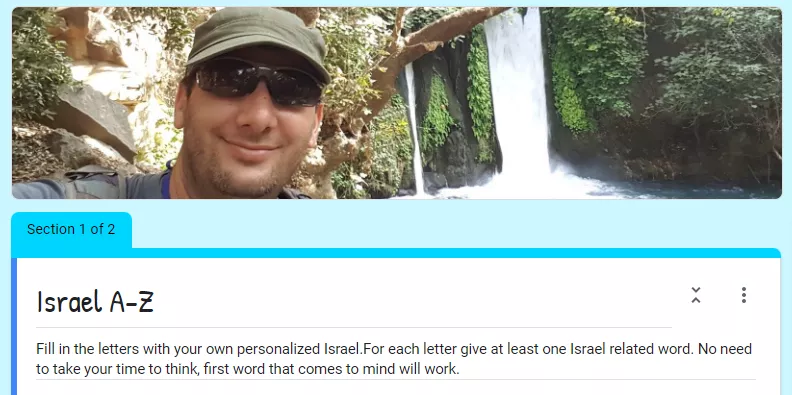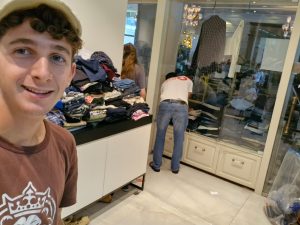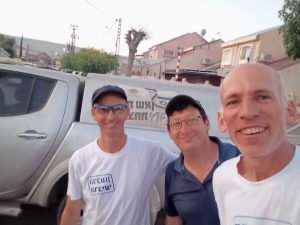Israel A – Z
Recommendation: Complete the Israel A-Z challenge before you read. https://forms.gle/QeSuA9iWQBGsVudv7
In 2007 I was appointed Shalich, emissary, for the Jewish Agency for Israel’s (JAFI) Department of Education to the Southwest region of the United Synagogue Youth (USY). This position covered five western states of the US, with approximately 40 conservative congregations, 25 youth chapters and hundreds of youth participants. I was responsible for Israel and Jewish engagement and education as well as recruitment for summer and year-long programs in Israel. In addition to working with the regional officers, chapter officers and youth professionals, the job offered lot of room for creativity and partnership. Looking back, I can say it was extraordinary. I found ways to engage way beyond my original scope. Rabbis and congregations, Israel committees and rabbinical students became friends and partners. Schools, camps, campus Hillels, Jewish Student Union clubs, members of the local BJE (Bureau of Jewish Education, today known as Builders of Jewish Education) and others were among the many area Jewish organizations with which I was privileged to work. I regularly collaborated with the Israel consulate in Los Angeles and other members of the JAFI’s western Shlichim team. It was a magnificent time, during which I grew not only as a person but also as a Jewish and Israel Educator.
On first arriving in the area, one of my first tasks was to understand the existing depth of knowledge about Israel and to take the “Israel emotional temperature.” In simple words – what do they know… and how do they feel… about Israel? Getting a grip on these issues would allow me to build on existing knowledge and introduce new and important topics. So, I developed a tool, which I named “Israel Quiz.” The concept was adapted from the well-known annual international Bible contest, sponsored by the Israel Ministry of Education. The contest begins with quizzes offered in schools around the globe. From there it escalates to regional quizzes. And finally, it culminates with the international quiz, which takes place each year in Jerusalem during Yom Ha’atzmout, Israel’s Independence Day, and is broadcast live on Israeli TV. Together with the regional office staff we developed the quiz, created a logo, put together a marketing plan, and got to work.
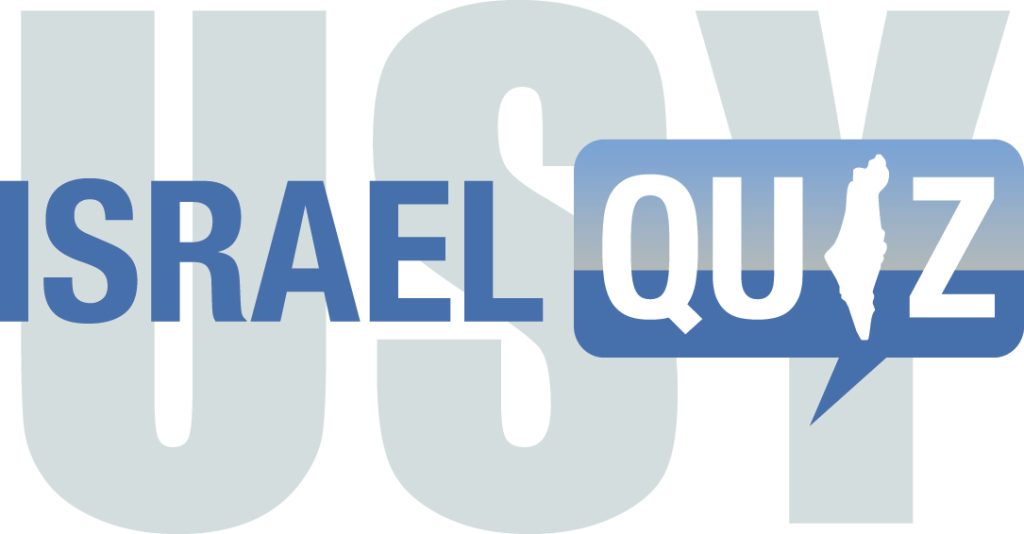
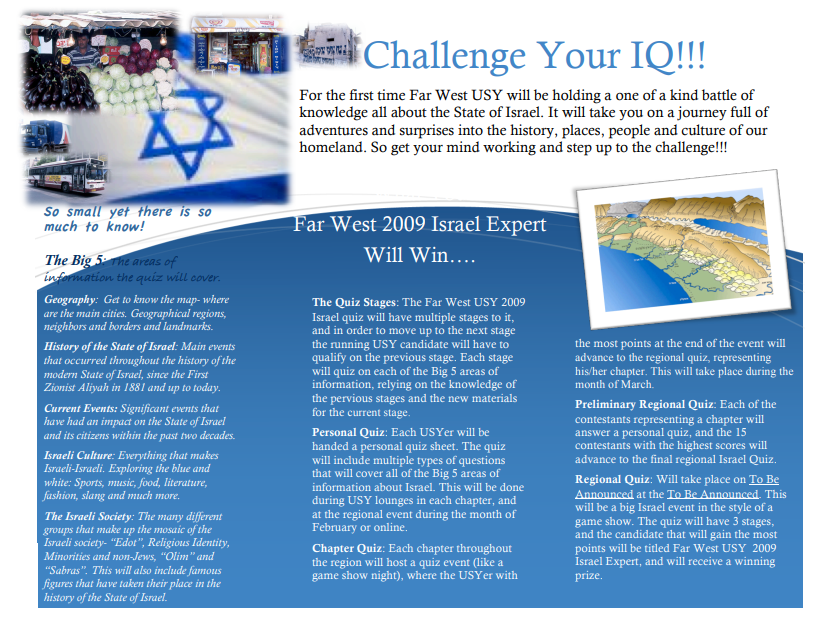
Challenge Your IQ!!! For the first time Far West USY will hold a one-of-a-kind battle of knowledge… all about the State of Israel. It will take you on an adventure-filled journey, introducing you to surprises throughout the history, places, people and culture of our homeland. So, get your mind working, and step-up to the challenge!!!
The Israel quiz defined five areas of content regarding Israel: “The Big 5.”
Geography: Get to know the map of Israel – Where are the main cities and geographical regions? Who are its neighbors? Where do sit the borders and landmarks?
History of the State of Israel: What pivotal developments and events took place throughout the history of the modern State of Israel, starting with the First Zionist Aliyah in 1881, up to today?
Current Events: What significant events have had an impact on the State of Israel and its citizens within the past two decades?
Israeli Culture: What makes a thing “Israeli?” Exploring the blue and white: sports, music, food, literature, fashion, slang and much more.
Israeli Society: Many groups make up the mosaic of the Israeli society – “Edot,” religious Identity, minorities and non-Jews, “olim” and “sabras,” and famous figures that have taken their place in the history of the State of Israel.
The Israel quiz was set up with multiple levels, and for competitors to move-up to the next level they must qualify in the previous one. Each level includes questions and discussions about every area of the Big 5. They rely on knowledge from the previous levels and on focused new materials for the current stage.
First, I launched a personal quiz on a survey monkey. This quiz was made up of fifty questions with multiple answers – ten for each of the Big 5 topics. In addition to collecting answers, the survey collected the names of the participants and their chapters. This survey gave me a regional picture of Israel knowledge and illustrated differences and knowledge gaps between chapters.
Following the personal quiz, I traveled throughout the region and ran chapter quizzes, running events with a game-show style PowerPoint quiz with various questions, pictures, songs and video clips. The chapter quizzes were run by me or by the local chapter leaders. The objective was to name the contestant with the highest number of points at the end of the event the “chapter representative” to the regional quiz. We also allowed smaller chapters (which did not have the opportunity to run a chapter event) to send a competitor to the regional quiz.
Finally, the regional event took place at the Skirball Cultural Center in Los Angeles. Guests and parents were invited to be in the audience. We secured a Jewish Hollywood actor to host the event and a panel of judges, including representatives of the JAFI team in Los Angeles at the time. The winner was awarded a monetary prize to be used toward a summer program in Israel.
It was a four-stage event, beginning with a 2-minute video illustrating short clips from 20 significant events from throughout the history of the state of Israel. Competitors needed to recognize those events, though a variety of questions, including those asked by Nativ students in Israel, via video, and a final question from the Consul General of Israel in Los Angeles at the time Mr. Yaki (Jacob) Dayan.
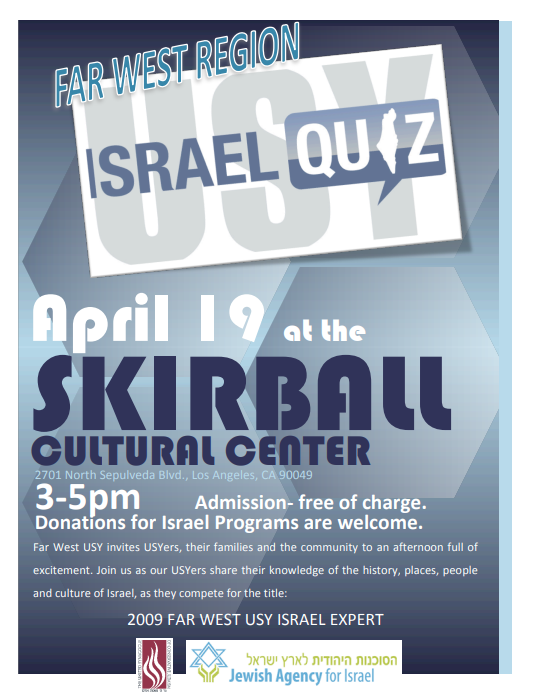
In addition to being fun and educational, the Israel quiz provided me with a good sense of the depth of knowledge (and lack thereof in some cases) of the students in my region. The quiz became a key tool which led to my success in providing needed Israel and Jewish education content during my time in the region.
Some of what I learned during the process might not have been surprising, but it could not be ignored. First, there was a clear and distinct difference in knowledge between students who attended public school and those who attended private Jewish day schools. Second, there was a clear and distinct difference between students who had traveled to Israel in the past and those who had never been. This, of course, is a key component of the various organized teen and youth travel projects to Israel, including school trips, camp and youth trips, Taglit-Birthright Israel, Masa long term program. Third, the depth of knowledge in general was rather surface. Clichés and code words masked a poor understanding of historic background, content, and knowledge. Attempts to draw out extensions and clarifications were mostly met with silence.
The teenagers were encouraged to ask questions and apply critical thinking about any topic presented to them. This made it easier to introduce topics and issues for discussion and conversation, such as the Gilad Shalit prisoner exchange, or 2008’s Israeli Operation Cast Lead in Gaza.
Following the Israel Quiz I created a tool that is much easier to use, creates a lot of fun, and gets me similar results. I named it “Israel A-Z (A to Z).” Israel A-Z is a simple sheet of paper with the Alphabet running down it. Each line has one letter followed by an empty line. The participants are asked to take their time and fill-in the blank next to each letter with at least one word relating to Israel. When asked what exactly I am looking for, my answer is “anything, as long as you can explain its connection to Israel.” I don’t specify, and I don’t give examples. I am looking for anything that comes to mind. This exercise, based on the first thing that comes to mind, is associative and culturally influenced. It has become one of my most well-known tools, and to date I have done this exercise with thousands of participants, from varied background and in different settings.
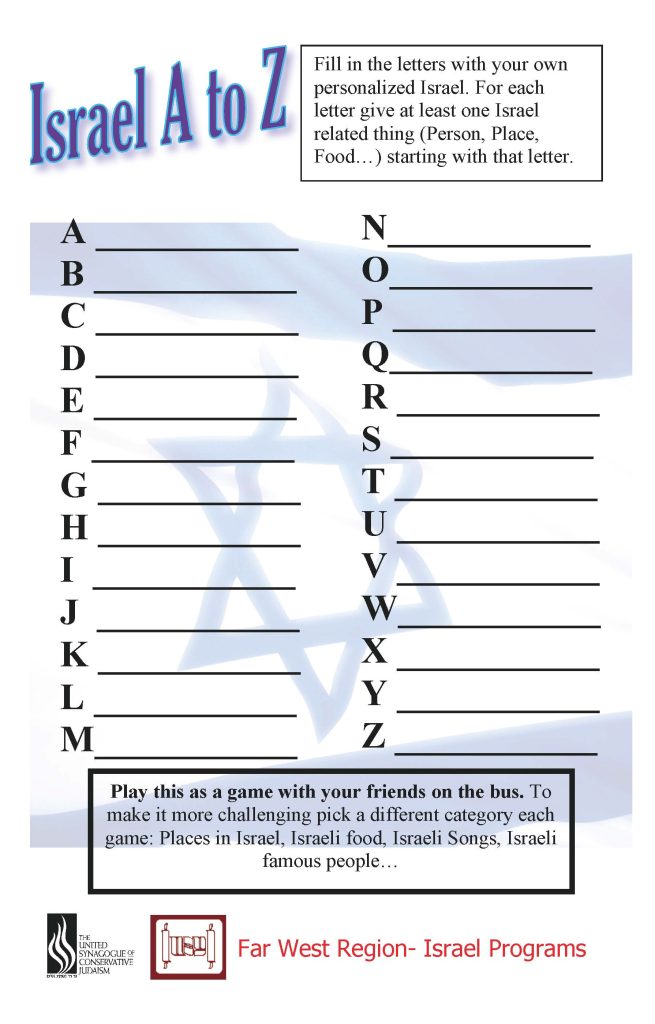
One popular setting for Israel A-Z is on a long bus or car ride with tourists in Israel. If it comes at the beginning of the trip, it gives me an indication of what they know. If it’s towards the end (perhaps as a trip summary), it allows us to reflect on what we have accomplished. But regardless of the results… it is the process that is important.
After everyone in the group finishes their sheet (or gets frustrated because they can’t find a word for a letter), the fun begins. I open the microphone and ask them to share their answers by calling them out. I start with the letter A, and the answers come in. As I catch the answers, I repeat them over the microphone. Often, I’ll hear from the group things like: “I have that too! I should have written that! How didn’t I know that!” and similar exclamations. When certain words or topics emerge, it also enables me to elaborate – either reminding the group things we’ve seen or discussed, or to frame things we are going to see or experience. It can also provide an opening or segway to a topic in which I want to engage them. When I feel we have exhausted a letter, I move on and shout out the next letter down the line, and the process starts again. This goes on until we finish the entire alphabet. The length of the activity depends on the group, and it generally runs very well.
The next stage is to ask participants to go back to their answers and categorize them. They can create a symbol or color coding for each category and mark it next to the words. Check marks, stars, circling, and underlining are just some of the methods used. I help with the categories and offer sites and places, food, culture, Jewish, superlatives, private and personal connections. It is very interesting to see the answers gathered by categories. With a homogeneous group you can do the whole sheet based on just on one topic, and many times during a trip one or two of the participants end up with a one-topic sheet such as foods eaten throughout the country, places and sites visited, people they’ve met during the trip, or even a page full of superlatives.
Interest Groups will most likely be reflected on their sheets. For example, Christian pilgrimage and biblical tours will reflect biblical sites and words of faith. Families that are on vacation will have many sites, superlatives, and personal inside jokes and experiences. The more diverse the travel itinerary, the more categories we will receive. One of the more command categories that appear is ‘Jewish’. Many people associate Jewish aspects with the State of Israel. Israel is defined and identified as a Jewish State, yet I don’t give any direction or definition beyond “Israel.” Not the State of Israel; not the Land of Israel; no narrowing concepts. What is interesting to note is that words like: kosher, tefillin, Yom Kippur, and others appear quite often. They are definitely Jewish yet not bound nor restricted to Israel. I could say, Israel brings out the Jewish in the visitor. And when I say visitor, I mean everyone – regardless of faith, cultural or ethnic background, religious affiliation, type or level of observance.
The declaration of the “the Establishment of a Jewish State in Eretz-Israel, to be known as the State of Israel” defines Israel as a Jewish State. And it is very clear to any visitor, regardless of the fact that a large number Israeli citizens are not Jewish (2023 -26.5%)[i], that the public sphere in Israel is, by all means, Jewish. Most of the people in the streets are Jewish. The most common spoken language is Hebrew – the language of the Jewish People. Shabbat is the day of rest, and the year-round holiday cycle, school vacations and workdays, are based on the Jewish Hebrew calendar.
Non-Jewish sites are kept pretty insular. If one was not interested, Christian churches – some of the holiest in the world – could easily be overlooked. Actually, until you step foot into the courtyard of a Christian site, its existence is essentially hidden. World travelers, especially those who go to Europe, can relate to this observation. In most European countries, even the most secular ones, with legal separation between Church and State, a Christian public sphere is visible, noticeable, and present. Israel is the only place in the world where the public sphere is Jewish, it is visible, noticeable, and present, and very much reflected in Israel A-Z.
All of this leads us to a serious question: What is missing? What parts of Israel are not represented or are inadequately represented in Israel A-Z? In other words: what dimensions/topics of Israel are completely absent – having no representation on the A-Z sheet. And what topics appear but in a very surface manner. Recalling that this is a ‘what comes to mind first’ exercise which can be heavily influenced by a lack of group diversity, we must acknowledge that the goal of the exercise is to provide a means to engage participants in a more meaningful, more diverse and colorful Israel, and to be able to give tools to engage with Israel’s wider scope.
When it comes to geography, as expected… sites, cities, and regions that we’ve visited are the first to appear. Regarding Israeli culture, foods generally appear first, with Falafel, by far, the most common word for the letter F. Same goes for Hummus, Pita and other traditional Israeli foods. Wine lovers will include a winery or a label that they either enjoy back at home or that they visited during an Israel trip. The younger crowd might present an Israeli contemporary singer, band or song, while an older crowd is more likely to mention a name such as Naomi Shemer or her famous song, Jerusalem of Gold. Yet, seldom will we get the name of an Israeli theater actor, author, poet or even the name of a popular TV show such as Eretz Nehederet. By far the most absent topic is culture. The growing entrance of Israeli content into the global market, such as popular TV series, has had an influence on the world’s knowledge of Israel, and respectively on my A-Z, but not enough. Regarding politics I see two types of A-Z sheets. The first are from participants that are interested and engaged in current Israeli politics and the Israeli-Palestinian conflict, and therefore related words will be present on their sheets in a high percentage. With a trained ear one can determine through the words and concepts of their responses the political mindset behind them, or at least the source of their Israel knowledge. This is by no means a statement of judgment or taking a political stand. It is simply an observation, and an important one in my view.
The second group are those with less knowledge and engagement in current Israeli politics. Again, we can divide this group into two. The older crowd which knows the names of our important current political leaders and may also know their political party affiliation. This group will also know (and be proud of) historical Israeli political leaders, including David Ben-Gurion, Menachem Begin, Golda Meir, and Yitzhak Rabin. The second group will know very little regarding historic or contemporary issues, and in many cases, they will dismiss the topic with statements like ‘I will never understand your political system; it makes no sense”.
As Israel has been globally recognized as a “Startup Nation” – a society of innovators and entrepreneurs, with contributions to almost every sector, I would expect that to be reflected in the A-Z. Yet, once again if we do get answers along this vein, they will be general statements such as “Startup Nation”, “innovation”, “entrepreneurs”, in contrast to names of specific individuals involved in these worlds, or names of companies and startups. Waze is one of the outstanding examples. It is an Israeli company purchased by google and used daily around the world. I assume this is the reason it is the most common particular Israeli Start-Up to make it onto my A-Z. Particular companies from the other sectors such as biotech, agro-tech, cyber and computers, and water tech are much more uncommon.
Hebrew as a language is reflected at times on our A-Z. First and foremost, in the form of the word Hebrew for the letter H. Then some slang that was taught throughout trips, visits, and Israel programming (ex. Sababa). Sites that have a Hebrew name and an English name, might be presented in their Hebrew form. And last, many words in Hebrew that have been gathered over the years, some from synagogue and temple, others from schools, camps, and youth movements. All these words are unified by the fact that the participants don’t understand them, they lack the knowledge of the meanings of the words.
It would be impossible to cover all the topics reflected or lacking. Israel A-Z became a thing. It actually became a “Zalman thing” and is reflected on my name appearing again and again for the letter Z (in compassion with Zionism). Israel A-Z, in the end, is a fun and engaging tool which provides an immediate personal and group reflection and understanding of their individual and collective knowledge of Israel.
I truly love my work. And Israel A-Z challenges me to find more ways to teach, relate and connect people to an ever changing, diverse and dynamic State of Israel. This is my mission… my ongoing mission.
If you have not filled out your personal Israel A-Z, or would like to give another go at it, you can do it here https://forms.gle/QeSuA9iWQBGsVudv7
[i] https://www.cbs.gov.il/en/mediarelease/pages/2023/israel-independence-day-2023.aspx
